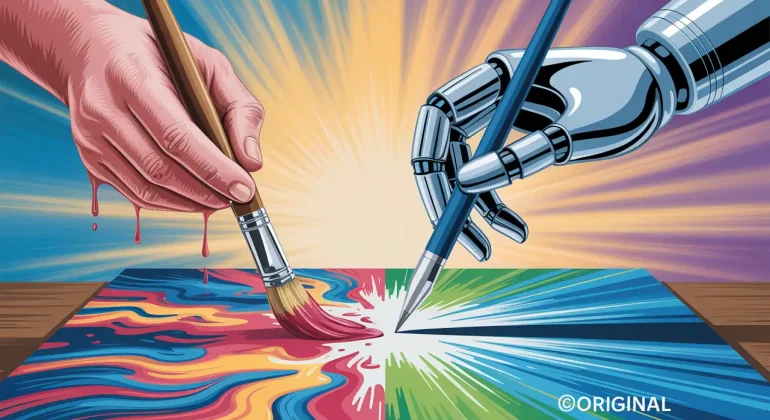Sommaire
AI-Generated creations: the question of human originality
The primary condition for copyright protection is originality, defined as the expression of the author’s personality. This condition automatically excludes any creation entirely generated by artificial intelligence, which cannot qualify as a natural person.
In France and throughout the European Union, the legal position is clear: only a human being can be considered the author of a work. Directive 2001/29/EC and the French Intellectual Property Code (articles L111-1 et seq.) confirm this approach.
The first European court decision on this issue was issued on October 11, 2023, by the municipal court of Prague. The court denied copyright protection for images generated using DALL·E, on the grounds that no human creative contribution was demonstrated.
It is therefore essential to distinguish between the exclusive use of AI to produce content and the use of AI as a tool assisting a human creative process. In the latter case, copyright protection may be available, provided a sufficiently substantial personal contribution can be demonstrated, such as through the drafting of the prompt and the selection of the final output. This principle is reaffirmed by the U.S. Copyright Office in its report to Congress and the general public, “Copyright and Artificial Intelligence,” with Part I, “Digital Replicas,” published in July 2024, and Part II, “Copyrightability,” in January 2025.
Training AI: the use of existing copyrighted works
A major legal issue today concerns the training of generative AI systems. These systems are fueled by billions of data points (texts, images, music, etc.), many of which are protected by copyright. The central question is whether such use can occur without prior authorization.
Directive (EU) 2019/790, transposed into French law in 2021, introduced a specific exception to copyright infringement for “text and data mining” (TDM). Under certain conditions, this exception allows for the automated extraction and analysis of large volumes of copyrighted texts or images to identify patterns, correlations, or trends. Its goal is to facilitate research and innovation, particularly in the field of AI, without requiring prior authorization from rightsholders unless they have expressly objected to commercial uses.
Two regimes therefore coexist:
- TDM is mandatory for public scientific research. In practical terms, this means that copyright owners cannot oppose the exploitation of their protected works when this is carried out as part of a scientific research activity conducted by public or non-profit bodies (such as universities or research institutes).
- TDM may be excluded for commercial uses if rightsholders have expressly opted out or if a contractual clause so provides.
In the case LAION v. Robert Kneschke, No. 310 O 227/23, ruled on September 27, 2024, by the Regional Court of Hamburg, the TDM exception was upheld in favor of LAION. The organization was accused of using one of the photographer’s images, originally uploaded to the Bigstockphoto platform, as part of a dataset to train image-generating AI.
Although Bigstockphoto’s terms of use explicitly prohibited automated use, the court recognized that LAION met the criteria for the scientific research exception under Section 60d of the German Copyright Act (transposing Directive 2019/790), finding that the organization acted on a non-commercial and public-interest basis.
Legal framework and transparency in ai systems
To address the growing challenges of AI, regulations have multiplied to better protect intellectual property rights. Regulation (EU) 2024/1689 of June 13, 2024, establishes harmonized rules on artificial intelligence. It imposes enhanced transparency obligations for general-purpose generative AI systems. As of August 1, 2025, providers must:
- Publish a summary of the training data used (to the extent possible without disclosing trade secrets);
- Maintain technical documentation and training logs;
- Respect copyright, notably through opt-out mechanisms.
This regulation is a significant step forward for rightsholders, as it enables the identification of unauthorized data uses and may support licensing claims.
In parallel, French authorities, including the CNIL and the CSPLA, have engaged actively with the AI Act, detailing implementation methods and evaluating AI systems under the GDPR, particularly in terms of processing fairness and algorithmic transparency.
Towards fair remuneration for rightsholders
The widespread use of copyrighted works to train AI systems generates undeniable economic value and raises a central question about the remuneration of creators.
In response, French press publishers (Le Monde, AFP, Le Figaro, among others) have initiated actions against companies such as X (formerly Twitter) and Microsoft, asserting their neighboring rights and seeking fair compensation.
The ADAGP (Society of Authors in the Graphic and Plastic Arts) advocates for collective sector-specific licensing systems with equitable redistribution mechanisms.
Some companies had already anticipated this shift. Adobe, for example, offers a library of licensed AI-generated images, and OpenAI has signed licensing agreements with several international publishers.
These practices suggest a promising balance between technological innovation and respect for authors’ rights.
Conclusion
Copyright law remains a fundamental tool for regulating the rise of generative AI. By combining human creative input, data traceability, appropriate licensing, and respect for legal exceptions, businesses can secure their use of AI while promoting innovation. Upholding these principles protects both rightsholders and AI users.
Dreyfus Law firm assists its clients in managing complex intellectual property cases, offering personalized advice and comprehensive operational support for the complete protection of intellectual property.
Dreyfus Law firm is partnered with a global network of lawyers specializing in intellectual property.
Nathalie Dreyfus with the assistance of the entire Dreyfus team.
FAQ
- Can an AI-generated work be protected by copyright?
No, unless a sufficiently creative human contribution can be demonstrated. - Can generative AI models be trained on copyrighted works?
Yes, provided the TDM exception applies or a valid license has been obtained. - Can rightsholders object to their works being used by AI?
Yes, through an opt-out or by contractually prohibiting such use.


